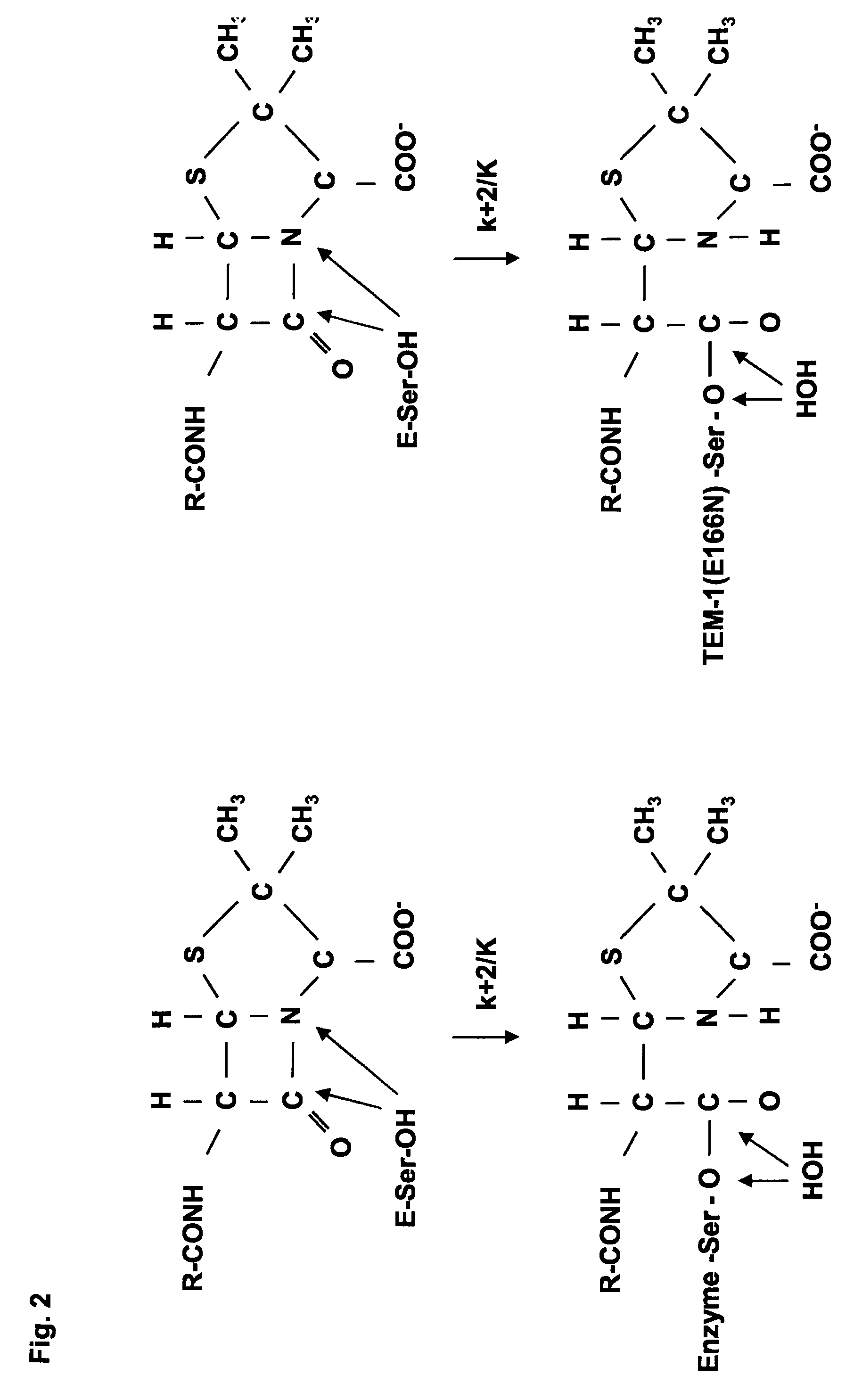Hybrid proteins of active-site serine β-lactamase
a technology of serine lactamase and active-site serine, which is applied in the direction of peptides, enzymology, dna/rna fragmentation, etc., can solve the problems of reducing the quantity of bifunctional proteins obtained, and affecting the quality of finished products
- Summary
- Abstract
- Description
- Claims
- Application Information
AI Technical Summary
Benefits of technology
Problems solved by technology
Method used
Image
Examples
example 1
Inserting Unique Restriction Sites in the Genes of the TEM-1, BlaP and BlaL β-Lactamases so as to Internalise Exogenous Nucleotide Sequences
[0150]The coding sequence of the β-lactamase TEM-1 which was used for internalising exogenous sequences of peptide initially contains a KpnI restriction site. In order to broaden the range of DNA fragments to be internalised in the carrier protein, two types of restriction cassettes were inserted into the KpnI site (FIG. 3). Among the new restriction sites, the SmaI site produces blunt ends compatible with all nucleotide fragments also having blunt ends. This change provides a means of making out the internalisation of the random nucleotide fragments originating with a gene of interest or the genomic DNA of any organism. E. coli production assays have shown that the new TEM-1 hybrid proteins retain their β-lactamase activity after the restriction cassettes have been internalised.
[0151]As FIG. 4 shows, the 3D structure of the BlaP β-lactamase of ...
example 2
Synthesis of Hybrid Proteins TEM-1 and the Thermostable Enterotoxin STa of Escherichia coli (TEM-STA)
[0152]STa is a thermostable toxin mainly produced by enterotoxic Escherichia coli (E. coli) strains found either in animal as bovine or in human. STa induces severe and lethal diarrhoea in human and new borne calf respectively (Mainil J, 2000). The thermostable enterotoxin STa is a polypeptide of 18 amino acid residues. It exhibits a discrete three-dimensional structure, which is stabilised by the presence of three disulfide bonds (Gariepy et al, 1986; Shimoniski et al, 1987). The native fold of the polypeptide only mediates the toxicity.
[0153]The small size of STa does not allow its recognition by the host immune system and no anti-STa antibodies can be produced. Therefore, no protection of the host and no vertical protection (mother-foetus) are possible.
[0154]In order to develop an immune response against STa, the 18 residues can be linked to a large protein (called the carrier pro...
example 3
Selection of Permissive Sites
[0156]When performing the present invention the STa amino acid sequence was introduced into eight different positions of TEM-1. Namely, STa was placed after amino acid residues 37, 197, 198, 206, 216, 218, 232 and 260 of TEM-1 respectively (FIG. 6).
[0157]Those hybrid proteins were obtained by introducing the DNA coding sequence for the 18 amino acid peptide STa into the gene ampR of pBr322. The different hybrid proteins were produced in E. coli. The production of a stable and active enzyme was tested as follow:
[0158]a) Western blot with anti-TEM antibodies were performed to verify the production of the hybrid.
[0159]b) Determination of the MIC (minimal inhibitory concentration) of ampicillin for the different E. coli strains.
[0160]These data indicated that three different types of insertion sites could be defined. The sites in position 197, 198, 216 and 218 are permissive (detection of TEM by western blot and high MIC values). The sites in position 37, 20...
PUM
| Property | Measurement | Unit |
|---|---|---|
| pH | aaaaa | aaaaa |
| pH | aaaaa | aaaaa |
| pH | aaaaa | aaaaa |
Abstract
Description
Claims
Application Information
 Login to View More
Login to View More - R&D
- Intellectual Property
- Life Sciences
- Materials
- Tech Scout
- Unparalleled Data Quality
- Higher Quality Content
- 60% Fewer Hallucinations
Browse by: Latest US Patents, China's latest patents, Technical Efficacy Thesaurus, Application Domain, Technology Topic, Popular Technical Reports.
© 2025 PatSnap. All rights reserved.Legal|Privacy policy|Modern Slavery Act Transparency Statement|Sitemap|About US| Contact US: help@patsnap.com



